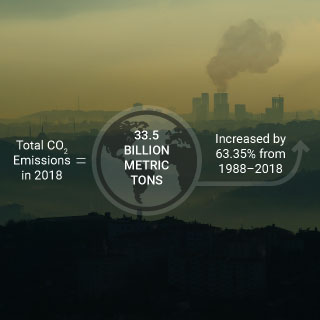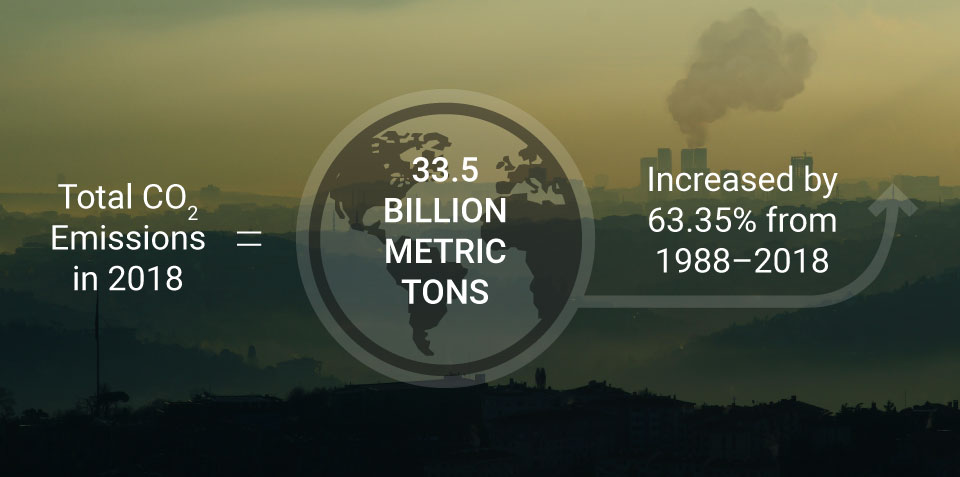Climate Change Mitigation: Role of Social Cost of Carbon

The Carbon Discount: Contextualizing Social Cost of Carbon for Climate Change Mitigation
Globally, there has been a general increase in carbon dioxide (CO2) emissions from 1850 to 1960 owing to factors such as population growth and industrialization. Comparing the highest emitting countries, the United States of America was ranked second in 1850. In 2011, a similar comparison showed that the USA ranked second again. The difference, however, was that their emissions grew by 266 times over 160 years. A similar intensification holds true for the other high carbon-emitting nations (World Resources Institute 2014). Build-up of carbon emissions in the atmosphere results in global warming. This leads to rising sea levels and erratic weather patterns that spur natural disasters resulting in significant economic damages to human health and environment (See Figure 1).
 Figure 1: Impacts of Kerala flood in 2018
Figure 1: Impacts of Kerala flood in 2018
Source: Sarkar S. 2019

Concerning the countries with highest carbon emissions, India with a total of 2.3 billion metric tonnes, accounts for 6.8% of total emissions in the world (IEA Data Browser 2021). Thus, the carbon-cutting measures that the global leadership take hereon will be crucial in climate change mitigation.
A phenomenon termed as ‘Hothouse Earth’ illustrates a scenario where the Earth’s temperature exceeds the threshold limit, plummeting it into a perpetually warm state where no countermeasures to reduce temperature will be effective. It is predicted that we are just 2° away from hitting the next hot earth stage. A full de-carbonization of the world economy by 2050 will still result in a temperature rise of 2.5° to 3° (Weyler R. 2018).
The largest greenhouse gas (GHGs) emitting sectors such as agriculture, transport, power generation and other industries are an indispensable part of every economy (refer to Figure 2). Despite the global community signing the Paris Climate Agreement and committing to reduce carbon emissions, the efforts fall short when non-market values such as damages to health and the environment are not accounted for. It is in this regard that the Social Cost of Carbon (SCC) stands relevant. The SCC is a monetary estimate of the economic damages incurred due to the emission of one ton of greenhouse gases into the atmosphere. The harmful externalities of climate change are monetized into economic terms. This serves as a comparable metric that can help decision-makers choose pathways leading to lesser emissions.
 Figure 2: Sector-wise CO2 emission share in India
Figure 2: Sector-wise CO2 emission share in India
Source: CO2 Emissions from Fuel Combustion, IEA 2021
How to derive the SCC?
The keyword surrounding SCC is that it is an estimate. Despite significant growth in understanding the relationship between climate change, carbon emissions and corresponding economic impact, the SCC values are predicted over a range. The primary tool used in the estimation of SCC is the Integrated Assessment Models (IAMs). Several factors, such as region covered, sectors covered, and global mean sea level rise, are considered while calculating the estimates. Conventionally, SCC calculations are characterized by five steps, as represented in Figure 3.
 Figure 3: Steps to calculate the Social Cost of Carbon (SCC)
Figure 3: Steps to calculate the Social Cost of Carbon (SCC)
Source: Bonney K. et al.
Today vs Tomorrow: Discount Conundrum
As mentioned above, the SCC calculations are based on scientific and research-based modeling. However, certain assumptions are made in deciding the final SCC value to be considered. These assumptions constitute value judgements as a reflection of the emphasis given to a future estimate. The aspect of discounting arises from the fact that damages from climate change occur in the future and come with a high level of uncertainty. Hence the classic ‘Now vs Future’ debate is on deciding the conversion value of future damages to the present-day value. A higher discount rate implies that future damages are less significant in comparison to the present value. Correspondingly, a low discount rate indicates that the future is valued as significantly as the present.
| Discount rate (%) | Global SCC (USD/ton of CO2) |
|---|---|
| 2.5 | 75 |
| 3 | 50 |
| 5 | 14 |
| 7 | 5 |
Table 1: Corresponding SCC value for varying discount rate
This is evident from the above table representing the global SCC values calculated per ton of CO2 according to the US Dollar rate in 2019. A higher discount rate reflects the trade-off on future damages and results in a low value of SCC.
Approaches to Discounting
There are two main approaches in determining an optimum discount rate that accounts for future damages while ensuring that present-day economic activities are not drastically hindered:
Descriptive Approach – In this method, the discount rates are determined by observing market rates of return achievable by investors on their present-day assets and studying the trend in consumers savings vs consumption choices. Having the rate of return as the determinant is deemed appropriate because investments made to mitigate future damages are financed based on today’s consumption. This ensures that investments made to reduce GHGs yield appropriate returns. The risk of missing out on high return-yielding investments can be avoided.
Prescriptive Approach – Contrasting to the above approach, this method is based on qualitative reasoning. The judgements of the analysts determine the discount rate that is backed by the moral and logical defence. This approach is inclined to have a lower discount rate, as most adopters believe that it is unethical to prioritize today over tomorrow when the future generations have no say in today’s policy decisions.
SCC: A Policy Enabler?
Cost-benefit analysis plays an important role in deciding the feasibility of a project. Climate change damages are non-market values which have detrimental effects that will be experienced in the future. The SCC is a way to account for these future damages and include these non-market costs. In the absence of regulations that mandate SCC accounting, industries have no measure of regulating their carbon emissions. The United States, under the Trump administration, saw the SCC value drop from $52 to $7. This was achieved by using a high discount rate, and previously denied projects were justified with the new estimate. Avoiding climate change costs today only result in penalties in the future. A recent re-calculation by climate change experts that accounts for changes globally, has the current Biden administration staring at a whopping $125 SCC value to meet its climate change goals (Stone M. 2021).
While the SCC plays an important role in accounting for climate change damages, efforts need to be made for providing a regional context to the value. Developing countries are likely to experience higher environmental costs due to economic dependence on climate-sensitive industrial sectors and a growing population. (Griffiths C. et al.). A recent study by Rick et al. (2018) has determined country-level SCC (CSCC) using a discounting method that accounts for the varying economic losses and disparate growth rates across nations. Such pursuits to obtain accurate SCC estimates are necessary to facilitate governments to meet their carbon reduction targets optimally. The alternative, is a world that discounts its future, ultimately headed towards no future. The fight against climate change has to be a global effort and it is essential that countries bear a fair cost, thus ensuring their cooperation.
Written by Varun BR with inputs from Bhawna Tyagi
Varun is a Research Intern at AEEE. He is currently enrolled in the Masters in Public Policy program at NLSIU, Bengaluru. A mechanical engineer turned policy student, Varun’s primary interest lies in energy policy. His dissertation explores business models for Distributed Energy Resources in India.




